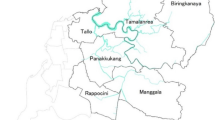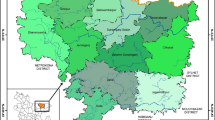Abstract
The spatial mapping of flood menace extents is crucial for the effective and competent enactment of risk-lessening strategy. We focused on geographical pattern and variation in flood-affected villages in Bongaon sadar sub-division, West Bengal, India, during the period between 1996 and 2016. To appraise the indigenous smoothing and dissimilarity of flood-affected/non-affected villages, GIS-based Voronoi statistics were used. Inverse distance weighting (IDW) is used to interpolate and predict the pattern of flood-affected/non-affected zones across the sub-division. Moran’s I index statistics was considered to appraise spatial auto-correlation among the flood affected and non-affected villages. Getis-OrdGi*(d) statistics was employed to recognize the flood hotspot and cold spot areas within the study site. The higher magnitude of Moran’s I was calculated as 1999–2001, 2004, 2011, 2013, 2015, and 2016. The high Z score was recorded in 1996–1999, 2001–2003, 2011, 2013, and 2014 indicated a spatial clustering of flood-affected villages. The predictive map derived through IDW showed that 7.76% (64.59 km2) area comes under very high threat zones of flood, followed by 16.27% as high risk, 24.49% as medium risk, 23.97% as low risk, and 27.51% as very low risk. This study determines the solicitation of GIS-based prophecy for the impost of revelation mapping, so as to define the latitudinal extent and frequency of areas where most affected villages are located and potential risk areas.






Similar content being viewed by others
References
Acharya SK, Chakraborty P, Lahiri S, Raymahashay BC, Guha S, Bhowmik A (1999) Arsenic poisoning in the Ganges Delta. Nature 401:545–545 discussion 547
Anselin L (1995) Local Indicators of Spatial Association—LISA. Geogr Anal 27(2):93–115
Chang K (2010) Introduction to geographic information systems, 5th edn. Thomas D. Timp, New York, pp 327–340
ESRI (2012) ArcGIS 10 Desktop Help Center. Retrieved August 1, (2012), from ArcGIS 10 Desktop Help Center: http://help.arcgis.com/en/arcgisdesktop/10.0/help/index.html
ESRI (2013) ArcGIS Resources. http://arcgis.com. Available from: http://resources.arcgis.com/en/help/. Accessed 18 Dec 2016.
Ghosh S, Mistri B (2015) Geographic concerns on flood climate and flood hydrology in monsoon-dominated Damodar River Basin, Eastern India. Geogr J Article ID 486740, 16 pages. https://doi.org/10.1155/2015/486740
Guha-Sapir D, Hoyois Ph, Below R Annual Disaster Statistical Review 2012: The Numbers and Trends. Brussels: CRED; 2013 Available at: http://www.cred.be/sites/default/files/ADSR_2012.pdf
Hagenlocher M, Hölbling D, Kienberger S, Vanhuysse S, Zeil P (2016) Spatial assessment of social vulnerability in the context of landmines and explosive remnants of war in Battambang province, Cambodia. Int J Disaster Risk Reduct 15:148–161
Klijn F, Kreibich H, de Moel H, Penning-Rowsell E (2015) Adaptive flood risk management planning based on a comprehensive flood risk conceptualisation. Mitig Adapt Strateg Glob Chang 20(6):845–864. https://doi.org/10.1007/s11027-015-9638-z
Kourgialas NN, Karatzas GP (2011) Flood management and a GIS modelling method to assess flood-hazard areas—a case study. Hydrol Sci 56(2):212–225
Loh JM (2012) K-scan for anomaly detection in disease surveillance. Environmetrics 22:179–191
Majumder R, Ghosh DK, Mandal AC, Patra P, Bhunia GS (2017) An appraisal of geomorphic characteristics and flood susceptibility zone using remote sensing and GIS: A case study in Bongaon Subdivision, North 24 Parganas (West Bengal), India. Int J Res Geogr (IJRG) 3(4):32–40
Mitchell A (2005) The ESRI guide to GIS analysis, vol 2. ESRI Press, 2005. In this topic Calculations Interpretation Output Best practice guidelines FAQs Potential applications Additional resources
Mollah S (2016) Assessment of flood vulnerability at village level for Kandi block of Murshidabad district, West Bengal. Curr Sci 110(1):81–86
Mondal M, Satpati LN.(2012) Morphodynamic setting and nature of bank erosion of the Ichamati River in Swarupnagar and Baduria Blocks, 24 Parganas (N), West Bengal, Indian. J Spat Sci 3.0(2) Winter, Issue 2012, pp 35–43
Mondal I, Bandyopadhyay J, Paul AK (2016) Estimation of hydrodynamic pattern change of Ichamati River using HEC RAS model, West Bengal, India. Model Earth Syst Environ 2:125
Ord JK, Getis A (1995) Local spatial autocorrelation statistics: distributional issues and an application. Geogr Anal 27(4)
Papathoma-Köhle M, Promper C, Glade T (2016) A common methodology for risk assessment and mapping of climate change related hazards—implications for climate change adaptation policies. Climate 4(8):1–23
Phillips D, Ghosh D (2014) Testing the disjunction hypothesis using Voronoi diagrams with applications to genetics. Ann Appl Stat 8(2):801–823
Preston BL, Yuen EJ, Westaway RM, (2011) Putting vulnerability to climate change on the map: a review of approaches, benefits, and risks. Sustain Sci 6(2):177–202
Risi RD, Jalayer F, Paola FD, Lindley S (2018) Delineation of flooding risk hotspots based on digital elevation model, calculated and historical flooding extents: the case of Ouagadougou. Stoch Env Res Risk A 32:1545–1559. https://doi.org/10.1007/s00477-017-1450-8
Samanta RK, Bhunia GS, Shit PK, Pourghasemi HR (2018) Flood susceptibility mapping using geospatial frequency ratio technique: a case study of Subarnarekha River Basin, India. Model Earth Syst Environ 4(1):395–408
Sanyal J, Lu XX (2003) Application of GIS in flood hazard mapping: a case study of GangeticWest Bengal, India. Map Asia Conference. Available at: https://www.academia.edu/5476217/Application_of_GIS_in_flood_hazard_mapping_a_case_study_of_Gangetic_West_Bengal_India
Shivaprasad Sharma SV, Roy PS, Chakravarthi V, Srinivasarao G, Bhanumurthy V (2017) Extraction of detailed level flood hazard zones using multi-temporalhistorical satellite data-sets – a case study of Kopili River Basin, Assam, India. Geomatics, Natural Hazards and Risk 8(2):792–802. https://doi.org/10.1080/19475705.2016.1265014
UNISDR (2015) Global assessment report on disaster risk reduction. making development sustainable: the future of disaster risk management. Geneva, Switzerland
Vadrevu KP, Csiszar I, Ellicott E, Giglio L, Badarinath KVS, Vermote E, Justice C (2013) Hotspot analysis of vegetation fires and intensity in the Indian Region. IEEE Journal Of Selected Topics In Applied Earth Observations And Remote Sensing 6(1):224–238
Van Doorn-Hoekveld WJ, Goytia SB, Suykens C, Homewood S, Thuillier T, Manson C, Chmielewski P, Matczak P, van Rijswick HFMW (2016) Distributional effects of flood risk management—a cross-country comparison of preflood compensation. Ecol Soc 21(4):26
Acknowledgments
We extend our thanks to the Department of Geography, Raja N. L. Khan Women’s College (Autonomous), Medinipur, India, for providing necessary facilities and logistic support for conducting the research work.
Conflict of interest
on behalf of all authors states that there is no conflict of interest.
Author information
Authors and Affiliations
Corresponding author
Additional information
Editorial handling: Ibrahim Demir
Rights and permissions
About this article
Cite this article
Majumder, R., Bhunia, G.S., Patra, P. et al. Assessment of flood hotspot at a village level using GIS-based spatial statistical techniques. Arab J Geosci 12, 409 (2019). https://doi.org/10.1007/s12517-019-4558-y
Received:
Accepted:
Published:
DOI: https://doi.org/10.1007/s12517-019-4558-y




